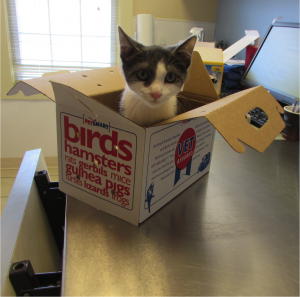Cats, like humans, are creatures of habit. Once comfortable in their surroundings, they are unnerved by change. And trading a familiar home for an unfamiliar one can cause fearfulness and stress. Unless you, the conscientious cat guardian, plan ahead with all the precision of a successful military campaign. Logically, then, moving from one place to another should consist of three stages: preparing for the move; moving day itself; and settling into your new home.
PREPARING FOR THE MOVE
Purchase a large, comfortable carrier and give your cat sufficient time to adjust to being in it. Leave it on the floor with the door open and some treats inside. Keep replacing the treats after your cat has retrieved them.
Set out your cardboard, moving boxes a few days before you actually begin to pack so that your cat can get used to the sight and scent of them.
Maintain your cat’s regular routine for feeding, play and exercise, and quality together time.
If your cat becomes anxious as you start packing, place him/her in a quiet room with some toys and treats and keep the door closed. On the other hand, if your cat is an especially nervous cat, boarding him/her in a professional kennel the day before and after the move may be the best solution — for all of you.
Make certain that your cat’s identification tags carry your new address and phone number. But the best precaution — and the wisest investment you can make — is an updated microchip implant.
Even before the movers take over the premises, tuck your cat safely away from the center of the storm by closing him/her in a bathroom, together with food, water, a bed and a litter box.
To ensure that your cat doesn’t panic and try to escape if the door is opened, put a sign on the door stating that it must remain shut.
Your cat should always travel with you, secure in the cat carrier, and not in the moving van.
SETTLING INTO YOUR NEW HOME
Put your cat in a room that will remain relatively quiet for awhile. Before opening the carrier, lay out your cat’s food and water dishes, litter box and bed, and place some treats around the room.
Keep your cat in this one “safe” room for a few days, spending time together, soothing and cuddling, and sharing some low-key activities like reading, listening to music or watching TV.
Cat-proof your new home as soon as possible. Included in your “must do” list:
Tuck drapery, blinds and electrical cords out of reach; plug up narrow spaces where a cat might get stuck; ensure all windows and screens are secure; install childproof latches on your cabinets – particularly those containing cleaning supplies; cover unused electrical outlets with special plastic caps, and keep all toilet seats down.
To help acclimatize your cat more quickly, spritz various objects with a pheromone spray or spread your cat’s own scent (gathered from his/her face and neck) with a soft cloth along the walls, doors and furniture.
Begin gradually walking your cat through the rest of the place, one room at a time, constantly praising and reassuring him/her as you make the rounds. Over and over again.
Restore your cat’s former feeding, playing and exercise schedule so that, hopefully, it will seem that nothing has changed much at all.
Cats may be creatures of habit, but they are highly adaptable as well. And so, whether familiar or unfamiliar, old or new, for them, there is still no place like home.
————————————————————————————————————————————————————-
Article by Nomi Berger
Nomi is the best selling author of seven novels, one work of non-fiction, two volumes of poetry and hundreds of articles. She lives in Toronto, Ontario, Canada with her adopted Maltese, Mini, and now devotes all of her time volunteering her writing skills to animal rescue organizations throughout Canada and the USA.


